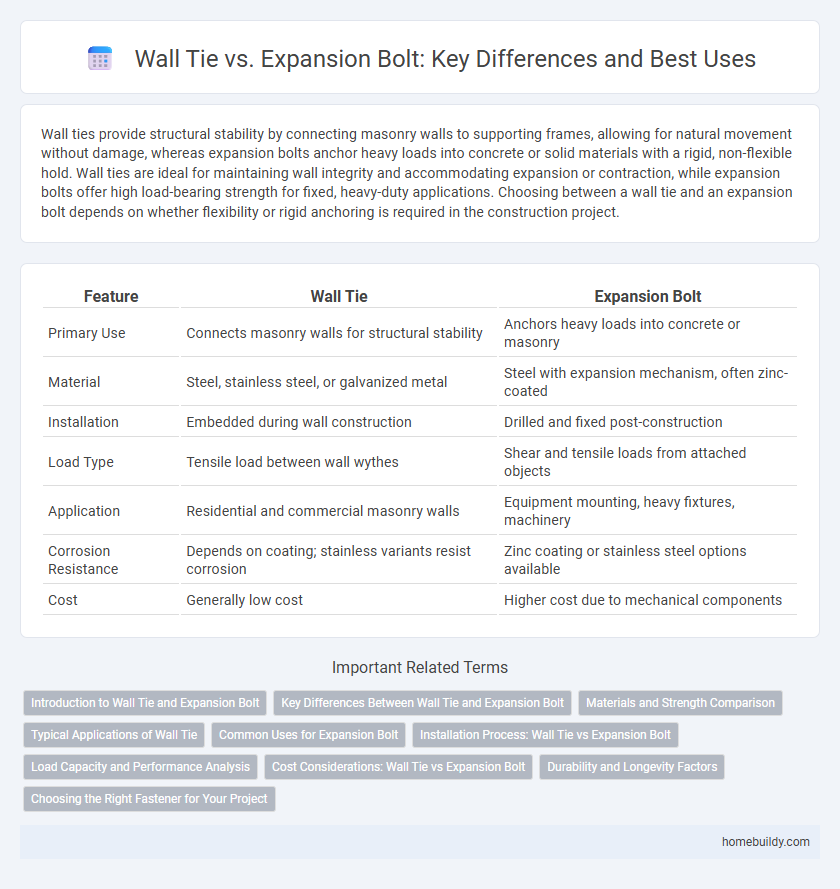Wall ties provide structural stability by connecting masonry walls to supporting frames, allowing for natural movement without damage, whereas expansion bolts anchor heavy loads into concrete or solid materials with a rigid, non-flexible hold. Wall ties are ideal for maintaining wall integrity and accommodating expansion or contraction, while expansion bolts offer high load-bearing strength for fixed, heavy-duty applications. Choosing between a wall tie and an expansion bolt depends on whether flexibility or rigid anchoring is required in the construction project.
Table of Comparison
| Feature | Wall Tie | Expansion Bolt |
|---|---|---|
| Primary Use | Connects masonry walls for structural stability | Anchors heavy loads into concrete or masonry |
| Material | Steel, stainless steel, or galvanized metal | Steel with expansion mechanism, often zinc-coated |
| Installation | Embedded during wall construction | Drilled and fixed post-construction |
| Load Type | Tensile load between wall wythes | Shear and tensile loads from attached objects |
| Application | Residential and commercial masonry walls | Equipment mounting, heavy fixtures, machinery |
| Corrosion Resistance | Depends on coating; stainless variants resist corrosion | Zinc coating or stainless steel options available |
| Cost | Generally low cost | Higher cost due to mechanical components |
Introduction to Wall Tie and Expansion Bolt
Wall ties are metal devices embedded in masonry walls to connect the outer wall to the inner structure, providing lateral stability and preventing separation due to wind or seismic forces. Expansion bolts are mechanical anchors used to attach loads to concrete or masonry by expanding and gripping the base material upon installation. Wall ties primarily maintain structural integrity between wall layers, while expansion bolts secure fixtures or structural elements to solid surfaces.
Key Differences Between Wall Tie and Expansion Bolt
Wall ties are primarily used to connect and stabilize masonry walls, ensuring structural integrity by tying the outer and inner walls together. Expansion bolts provide strong anchorage in solid materials by expanding against the base material when tightened, making them ideal for heavy load applications in concrete or stone. Unlike expansion bolts, wall ties do not provide direct load-bearing support but function to prevent wall separation and improve overall stability.
Materials and Strength Comparison
Wall ties are typically made from galvanized steel or stainless steel, providing excellent corrosion resistance and structural integrity in masonry applications. Expansion bolts, often composed of carbon steel or stainless steel, offer superior tensile strength and are designed for heavy load-bearing in concrete and solid materials. The choice between wall ties and expansion bolts depends on the specific structural requirements, with wall ties ideal for linking masonry layers and expansion bolts suited for anchoring heavy fixtures.
Typical Applications of Wall Tie
Wall ties are primarily used in masonry construction to securely connect outer walls to inner structural elements, ensuring stability and load transfer between layers. They are ideal for cavity walls, brick veneers, and retaining walls where thermal expansion and contraction must be accommodated without compromising structural integrity. Unlike expansion bolts, wall ties offer flexibility and corrosion resistance, making them suitable for long-term durability in damp or fluctuating indoor and outdoor environments.
Common Uses for Expansion Bolt
Expansion bolts are commonly used for securing heavy loads to concrete, brick, or stone surfaces in structural applications where strong, permanent anchoring is required. Unlike wall ties, which connect masonry veneers to structural walls for stability, expansion bolts provide high tensile strength for attaching machinery, steel columns, or heavy fixtures. Their reliable grip in solid substrates makes them ideal for construction, industrial installations, and infrastructure projects.
Installation Process: Wall Tie vs Expansion Bolt
The installation process of a wall tie involves embedding the tie into mortar joints between bricks or blocks to securely connect masonry walls, ensuring structural stability by distributing loads evenly. In contrast, expansion bolts require drilling precise holes into concrete or masonry, inserting the bolt, and tightening it to expand and grip the substrate, providing strong anchorage for heavy loads. Wall tie installation is typically faster and less invasive compared to the more equipment-intensive drilling and fixing process of expansion bolts, making each suitable for different structural applications.
Load Capacity and Performance Analysis
Wall ties exhibit superior load capacity by distributing tensile and shear forces evenly across masonry joints, enhancing structural integrity in load-bearing walls. Expansion bolts, while effective in anchoring to solid substrates, often demonstrate localized stress concentration, limiting their performance in dynamic load scenarios. Performance analysis reveals wall ties maintain consistent structural resilience under cyclic loading, outperforming expansion bolts in long-term durability and stability.
Cost Considerations: Wall Tie vs Expansion Bolt
Wall ties generally offer a more cost-effective solution for securing masonry walls compared to expansion bolts, due to lower material and installation expenses. Expansion bolts require specialized tools and labor, increasing overall project costs, especially in larger installations. Choosing wall ties can significantly reduce budget outlays in construction or renovation projects while maintaining structural integrity.
Durability and Longevity Factors
Wall ties offer superior durability compared to expansion bolts due to their corrosion-resistant materials and ability to accommodate structural movement without compromising integrity. Unlike expansion bolts, which may loosen over time under stress and environmental changes, wall ties maintain consistent performance in masonry applications. The longevity of wall ties is enhanced by their embedded position within the wall, protecting them from exposure to elements that often degrade expansion bolts.
Choosing the Right Fastener for Your Project
Wall ties provide structural stability by securely binding masonry walls to structural supports, ensuring flexibility and preventing cracks caused by thermal expansion. Expansion bolts offer strong, direct anchoring in solid materials but lack adaptability to movement, making them ideal for heavy loads but less effective in accommodating structural shifts. Selecting the right fastener depends on the specific application needs: wall ties for flexible, load-distributing connections in masonry, and expansion bolts for rigid, high-strength anchoring in solid substrates.
Wall tie vs Expansion bolt Infographic

 homebuildy.com
homebuildy.com